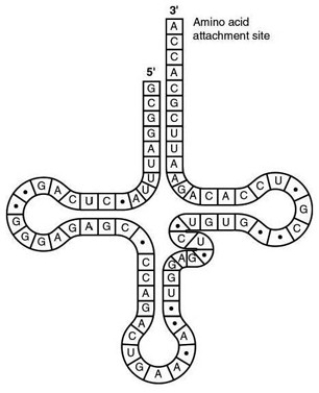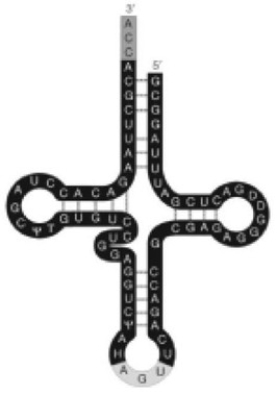A) once post-transcriptional modification is complete
B) before transcription is complete
C) once replication is complete
D) once the primary transcript has been released from RNA polymerase
Correct Answer

verified
Correct Answer
verified
Multiple Choice
 -The figure associated with this question represents a tRNA that recognizes and binds a particular amino acid (in this instance, phenylalanine) . Which codon on the mRNA strand codes for this amino acid?
-The figure associated with this question represents a tRNA that recognizes and binds a particular amino acid (in this instance, phenylalanine) . Which codon on the mRNA strand codes for this amino acid?
A) UGG
B) GUG
C) GUA
D) UUC
E) CAU
Correct Answer

verified
Correct Answer
verified
Multiple Choice
How does termination of translation take place?
A) The end of the mRNA molecule is reached.
B) A stop codon is reached.
C) The 5' cap is reached.
D) The poly-A tail is reached.
Correct Answer

verified
Correct Answer
verified
Multiple Choice
Which of the following mutations is most likely to cause a phenotypic change?
A) a duplication of all or most introns
B) a large inversion whose ends are each in the same region between genes
C) a nucleotide substitution in an exon coding for a transmembrane domain
D) a single nucleotide deletion in an exon coding for an active site
E) a frameshift mutation one codon away from the 3' end of the nontemplate strand
Correct Answer

verified
Correct Answer
verified
Multiple Choice
In eukaryotes there are several different types of RNA polymerase. Which type is involved in transcription of mRNA for a globin protein?
A) RNA polymerase I
B) RNA polymerase II
C) RNA polymerase III
D) RNA polymerase IV
E) primase
Correct Answer

verified
Correct Answer
verified
Multiple Choice
A particular triplet of bases in the coding sequence of DNA is AAA. The anticodon on the tRNA that binds the mRNA codon is ________.
A) TTT
B) UUA
C) UUU
D) AAA
Correct Answer

verified
Correct Answer
verified
Multiple Choice
Death cap mushrooms produce a substance called alpha-amanitin. Alpha-amanitin efficiently blocks synthesis of mRNA, but not of tRNA or rRNA, in eukaryotic organisms. This is possible because alpha-amanitin efficiently interferes with ________.
A) the action of RNA polymerase I, but not RNA polymerase II or III
B) RNA polymerase III, but not RNA polymerase I and II
C) the action of RNA polymerases I and II, but not RNA polymerase III
D) the action of RNA polymerase II, but not RNA polymerase I or III
Correct Answer

verified
Correct Answer
verified
Multiple Choice
Which one of the following statements about RNA processing is TRUE?
A) Exons are cut out before mRNA leaves the nucleus.
B) Ribozymes may function in RNA splicing.
C) RNA splicing can be catalyzed by tRNA.
D) A primary transcript is often much shorter than the final RNA molecule that leaves the nucleus.
Correct Answer

verified
Correct Answer
verified
Multiple Choice
There are 61 mRNA codons that specify an amino acid, but only 45 tRNAs. This is best explained by the fact that ________.
A) some tRNAs have anticodons that recognize 4 or more different codons
B) the rules for base pairing between the third base of a codon and tRNA are flexible
C) many codons are never used, so the tRNAs that recognize them are dispensable
D) the DNA codes for all 61 tRNAs, but some are then destroyed
E) competitive exclusion forces some tRNAs to be destroyed by nucleases
Correct Answer

verified
Correct Answer
verified
Multiple Choice
Accuracy in the translation of mRNA into the primary structure of a polypeptide depends on specificity in the ________.
A) binding of ribosomes to mRNA
B) shape of the A and P sites of ribosomes
C) binding of the anticodon to a small subunit of the ribosome
D) attachment of amino acids to rRNAs
E) binding of the anticodon to the codon and the attachment of amino acids to tRNAs
Correct Answer

verified
Correct Answer
verified
Multiple Choice
Which of the following processes is central to the initiation of transcription in bacteria?
A) binding of sigma to the promoter region
B) formation of a phosphodiester bond in the elongating RNA strand
C) binding of DNA polymerase to the promoter region
D) formation of a DNA primer
Correct Answer

verified
Correct Answer
verified
Multiple Choice
 -The tRNA shown with the previous question has its 3' end projecting beyond its 5' end. What will occur at this 3' end?
-The tRNA shown with the previous question has its 3' end projecting beyond its 5' end. What will occur at this 3' end?
A) The codon and anticodon complement one another.
B) The amino acid binds covalently.
C) The excess nucleotides (ACCA) will be cleaved off at the ribosome.
D) The small and large subunits of the ribosome will attach to it.
E) The 5' cap of the mRNA will become covalently bound.
Correct Answer

verified
Correct Answer
verified
Multiple Choice
Translation directly involves ________.
A) mRNA, tRNA, GTP, and DNA
B) mRNA, tRNA, ribosomes, and DNA
C) mRNA, ribosomes, GTP, and DNA
D) mRNA, tRNA, ribosomes, and GTP
E) tRNA, ribosomes, GTP, and DNA
Correct Answer

verified
Correct Answer
verified
Multiple Choice
Some viruses can be crystallized and their structures analyzed. One such virus is yellow mottle virus, which infects beans. This virus has a single-stranded RNA genome containing about 6300 nucleotides. Its capsid is 25-30 nm in diameter and contains 180 identical capsomeres. If the yellow mottle virus begins its infection of a cell by using its genome as mRNA, which of the following would you expect to be able to measure?
A) replication rate
B) transcription rate
C) translation rate
D) accumulation of new ribosomes
E) formation of new transcription factors
Correct Answer

verified
Correct Answer
verified
Multiple Choice
In comparing DNA replication with RNA transcription in the same eukaryotic cell, only DNA replication ________.
A) uses RNA polymerase
B) makes a new molecule from its 5' end to its 3' end
C) occurs in the nucleus of the cell
D) incorporates the entire template molecule in the product
Correct Answer

verified
Correct Answer
verified
Multiple Choice
In E. coli, if RNA polymerase is missing ________, then transcription initiation would not occur at the appropriate initiation sites.
A) amino acids
B) mRNA
C) sigma
D) the core enzyme
Correct Answer

verified
Correct Answer
verified
Multiple Choice
What ensures that the correct amino acid is added during translation?
A) the anticodon of a properly formed aminoacyl tRNA
B) the methyl-guanosine cap of a properly modified mRNA
C) the poly-A tail of a properly modified mRNA
D) the twisting number of a properly supercoiled DNA
Correct Answer

verified
Correct Answer
verified
Multiple Choice
 -In the figure associated with this question, what is the function of the AGU on the loop of the tRNA?
-In the figure associated with this question, what is the function of the AGU on the loop of the tRNA?
A) It attaches to the amino acid.
B) It base pairs with a codon of mRNA.
C) It stabilizes the tRNA-amino acid complex.
D) It is the active site of this ribozyme.
Correct Answer

verified
Correct Answer
verified
Multiple Choice
Translation requires ________.
A) mRNA, tRNA, DNA, and rRNA
B) mRNA, DNA, and rRNA
C) mRNA, tRNA, and rRNA
D) mRNA, tRNA, and DNA
Correct Answer

verified
Correct Answer
verified
Multiple Choice
There should be a strong positive correlation between the rate of protein synthesis and ________.
A) the quantity of DNA polymerase
B) the quantity of RNA polymerase
C) the size of mRNA
D) the number of ribosomes
Correct Answer

verified
Correct Answer
verified
Showing 21 - 40 of 58
Related Exams